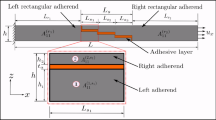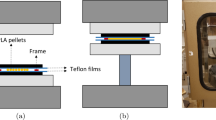Summary
The essential work of fracture (EWF) concept seems to be a proper and easy way to determine the inherent fracture behavior of ductile polymers. Unfortunately, all experiments reported until now were performed on polymers which did not meet the basic requirement of this fracture mechanical approach, viz. full ligament yielding prior to onset of crack growth. This problem often resulted in wrong conclusions and useless discussions on the specimen preparation, including notching techniques. By using tensile-loaded deeply double-edge notched (DDEN-T) specimens of amorphous copolyesters (aCOP) it was demonstrated that they are, in fact, the optimum choice to push forward the EWF concept for ductile polymers. Full ligament yielding before crack growth was evidenced by infrared thermographic (IT) frames taken during the loading of the DDEN-T specimens. The yielding “marked” with a load-drop in the corresponding load-displacement curves, enabled to split both the specific essential and non-essential work of fracture into their contribution terms: yielding and necking incl. fracture, respectively. It was argued that this EWF approach is most straightforward for the toughness description of such amorphous polymers that undergo necking by (multiple) shear banding without considerable strain-hardening, as aCOPs do.
Similar content being viewed by others
References
Mai, Y-W. and Cotterell, B.: On the essential work of ductile fracture in polymers, Int. J. Fract., 1986, 32, 105–125
Atkinson, A.G. and Mai, Y.-W.: Elastic and Plastic Fracture, Ellis Horwood, Chichester, 1988, Ch. 4, pp. 269–368
Saleemi, A.S. and Nairn, J.A.: The plane-strain essential work of fracture as a measure of the fracture toughness of ductile polymers, Polym. Eng. Sci., 1990, 30, 211–218
Mai, Y.-W. and Powell, P. Essential work of fracture and J-integral measurements for ductile polymers, J. Polym. Sci. Part B:Phys., 1991, 29, 785–793
Wang, M.-D., Nakanishi, E., Hashizume, Y. and Hibi, S.: Fracture energy analysis of single-edge-cracked isotropic ductile polyolefins, Polymer, 1992, 33, 3408–3414
Wu, J. and Mai, Y.-W.: Ductile fracture and toughening mechanisms in polymers, Mater. Forum. 1995, 19, 181–199
Broberg, K.B.: Critical review of some theories in fracture mechanics, Int. J. Fract. Mech., 1968, 4, 11–19
A testing protocol for conducting J-crack growth resistance curve tests on plastics, ESIS TC-4 group, 1994
Paton, C.A. and Hashemi, S.: Plane-stress essential work of ductile fracture for polycarbonate, J. Mater. Sci., 1992, 27, 2279–2290
Hashemi, S.: Ductile fracture of polyester films, Plast. Rubb. Compos., Process. Appl., 1993, 20, 229–237
Chan, W.Y.F. and Williams, J.G.: Determination of the fracture toughness of polymeric films by the essential work method, Polymer, 1994, 35, 1666–1672
Vu-Khanh, T.: Impact fracture characterization of polymer with ductile behavior, Theor. Appl. Fract. Mech., 1994, 21, 83–90
Testing protocol for essential work of fracture, ESIS TC-4 group, 1993
Karger-Kocsis, J. and Czigány, T.: On the essential and non-essential work of fracture of a biaxial-oriented filled PET-film, Polymer, 1996, 37, (in press)
Karger-Kocsis, J., Czigány, T. and Moskala, E.J.:Molecular relation of the plane stress ductile fracture of amorphous copolyesters determined by the essential work concept, J. Polym. Sci. Part B:Phys., (submitted)
Hashemi, S.: Plane-stress fracture of polycarbonate films, J. Mater. Sci., 1993, 28, 6178–6184
Levita, G., Parisi, L. and Marchetti, A.: The work of fracture in semiductile polymers, J. Mater. Sci., 1994, 29, 4545–4553
Author information
Authors and Affiliations
Rights and permissions
About this article
Cite this article
Karger-Kocsis, J. For what kind of polymer is the toughness assessment by the essential work concept straightforward?. Polymer Bulletin 37, 119–126 (1996). https://doi.org/10.1007/BF00313827
Received:
Revised:
Accepted:
Issue Date:
DOI: https://doi.org/10.1007/BF00313827




